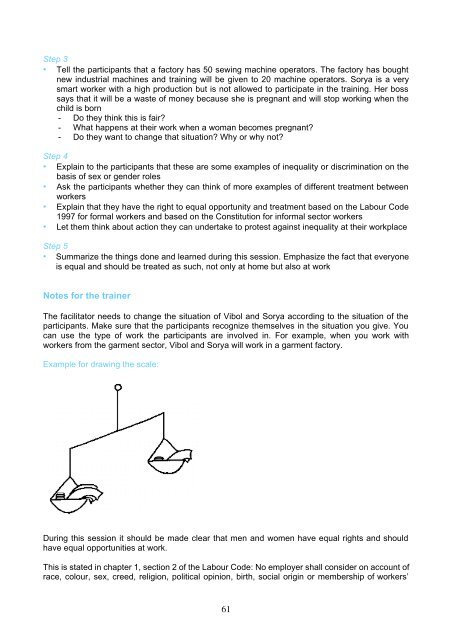manual: women workers' rights and gender equality - International ...
manual: women workers' rights and gender equality - International ...
manual: women workers' rights and gender equality - International ...
Create successful ePaper yourself
Turn your PDF publications into a flip-book with our unique Google optimized e-Paper software.
Step 3<br />
• Tell the participants that a factory has 50 sewing machine operators. The factory has bought<br />
new industrial machines <strong>and</strong> training will be given to 20 machine operators. Sorya is a very<br />
smart worker with a high production but is not allowed to participate in the training. Her boss<br />
says that it will be a waste of money because she is pregnant <strong>and</strong> will stop working when the<br />
child is born<br />
- Do they think this is fair?<br />
- What happens at their work when a woman becomes pregnant?<br />
- Do they want to change that situation? Why or why not?<br />
Step 4<br />
• Explain to the participants that these are some examples of in<strong>equality</strong> or discrimination on the<br />
basis of sex or <strong>gender</strong> roles<br />
• Ask the participants whether they can think of more examples of different treatment between<br />
workers<br />
• Explain that they have the right to equal opportunity <strong>and</strong> treatment based on the Labour Code<br />
1997 for formal workers <strong>and</strong> based on the Constitution for informal sector workers<br />
• Let them think about action they can undertake to protest against in<strong>equality</strong> at their workplace<br />
Step 5<br />
• Summarize the things done <strong>and</strong> learned during this session. Emphasize the fact that everyone<br />
is equal <strong>and</strong> should be treated as such, not only at home but also at work<br />
Notes for the trainer<br />
The facilitator needs to change the situation of Vibol <strong>and</strong> Sorya according to the situation of the<br />
participants. Make sure that the participants recognize themselves in the situation you give. You<br />
can use the type of work the participants are involved in. For example, when you work with<br />
workers from the garment sector, Vibol <strong>and</strong> Sorya will work in a garment factory.<br />
Example for drawing the scale:<br />
During this session it should be made clear that men <strong>and</strong> <strong>women</strong> have equal <strong>rights</strong> <strong>and</strong> should<br />
have equal opportunities at work.<br />
This is stated in chapter 1, section 2 of the Labour Code: No employer shall consider on account of<br />
race, colour, sex, creed, religion, political opinion, birth, social origin or membership of workers’<br />
61

















